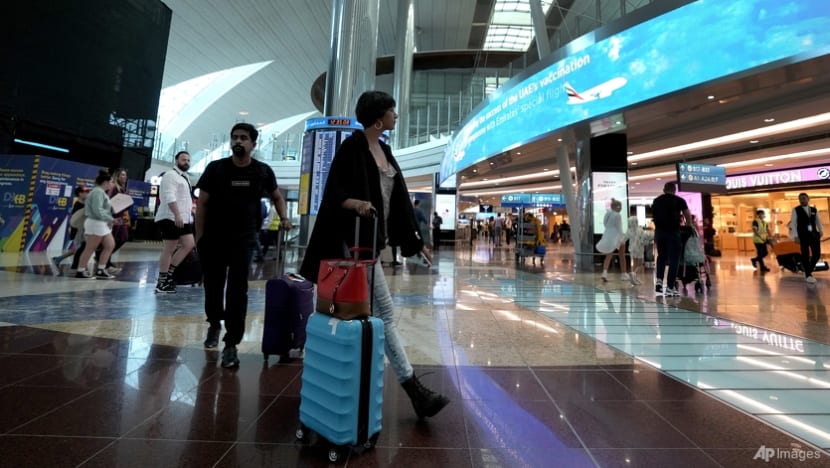Appetite for global travel at its highest since pandemic began, say industry players
The United Nations World Tourism Organisation reports that the travel sector has recovered to about 57 per cent of pre-pandemic levels.

SINGAPORE: Appetite for international travel in recent months is at its highest since the pandemic started, with industry players projecting sustained robust growth despite geopolitical uncertainties and global recession risks.
Pent-up demand for travel is fuelling the rapid growth, which is expected to outperform global gross domestic product (GDP) in 2023 - projected to slow to 2.7 per cent, according to the International Monetary Fund.
The travel industry is expected to buck the trend and enjoy growth of up to 5 per cent, said Mr Arnold Donald, chairman of the World Travel & Tourism Council (WTTC) on Tuesday (Nov 29).
“It’s not like it was a few decades ago when travel actually mirrored GDP. What we’ve seen now is GDP growth slowing, but the projections for the growth of travel for next year are going to be something like double the GDP growth,” he said.
"THE NUMBERS SPEAK FOR THEMSELVES"
COVID-19 and pandemic-induced measures in 2020 brought the industry to a near-standstill, grounding planes and cruises as borders closed and non-essential activities stopped.
But as of September this year, 86 countries have lifted all COVID-related restrictions, with many others easing their regulations.
The United Nations World Tourism Organisation (UNWTO) reported that the sector had recovered to about 57 per cent of pre-pandemic levels. International tourist arrivals almost tripled in the period from January to July this year, compared with a year ago.
“The numbers speak for themselves. It’s clear that there is a huge recovery ongoing,” Mr Donald told CNA’s Asia Now on the sidelines of the WTTC’s annual global summit in Riyadh, Saudi Arabia.
“Travel has rebounded very strongly, basically reflecting the intrinsic desire of people to be with loved ones, to experience nature and to experience new things. The forecast looks bright,” he said.
Related:
A survey by the WTTC showed that 63 per cent of respondents were planning a leisure trip in the next 12 months, while 27 per cent were planning three or more trips over the next year.
Mr Donald said that with the current trajectory, the industry expects more than 120 million new jobs to be created by 2030.
WORLD’S BUSIEST AIRPORT GETS BUSIER
Dubai International Airport (DXB), the world's busiest by international passenger traffic, said it was hopeful for a full recovery next year, after a robust 2022 buoyed in part by the ongoing football World Cup in neighbouring Qatar.
The city is seeing about 120 flights daily in both directions due to the tournament, and has forecast an additional 494,000 passengers for its second airport, Al Maktoum International Airport (DWC), in the fourth quarter this year.
“The traffic is intensifying month-on-month. So I think by the start of 2023, we will see the monthly throughput that is quite representative of pre-pandemic levels,” said Mr Paul Griffiths, chief executive officer of Dubai Airport.
“Overall, demand has never been stronger than we’ve seen over the last few months. Transfer traffic through DXB – we’ve got a little bit of a headroom to regain, but overall I think things are looking pretty good."
Dubai Airport saw 29.1 million international passengers pass through its halls last year - a number unmatched anywhere else in the world, but a far cry from pre-pandemic figures in 2019, when the airport served 86.4 million travellers.
This year, the airport expects to serve about 58.3 million passengers.
BRIGHT OUTLOOK AMID HEADWINDS
Mr Griffiths noted that the current demand-supply imbalance for flights was likely to correct itself, which could be good news for travellers.
“We are in a little bit of a bubble at the moment because so many aircraft are being grounded post-pandemic,” he said.
“As they replace fleets and the capacity increases, the demand-supply imbalance which we are currently seeing may correct itself.”
Despite the positive trajectory, global headwinds are expected with soaring inflation and risks of a global recession.
There are also concerns for destinations that have yet to fully open up from the pandemic, as well as locations experiencing geopolitical tensions and insecurity.
The industry however is not worried as “people still tend to travel,” said Mr Donald, adding that travellers typically work around undesirable situations.
These include opting for short flights instead of long-haul ones if cost is an issue, and avoiding locations where exchange rates are higher.
“With high inflation or a recessionary environment, people may choose different types of travel, they just modify to fit within the circumstances and within their budget,” he said.
He added that the outlook remains optimistic for pricing and booking trends in the long term.
Travel has been “remarkably robust and resistant” to inflationary measures in recent years, said Mr Griffiths. “Overall, I think there’s room for confidence despite the economic situation.”

















